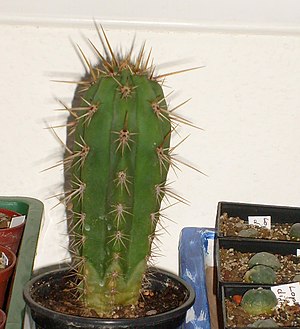Echinopsis peruviana
| Echinopsis peruviana | ||||||||||||
|---|---|---|---|---|---|---|---|---|---|---|---|---|

Echinopsis peruviana |
||||||||||||
| Systematics | ||||||||||||
|
||||||||||||
| Scientific name | ||||||||||||
| Echinopsis peruviana | ||||||||||||
| ( Britton & Rose ) H.Friedrich & GDRowley |
Echinopsis peruviana is a species of plant in the genus Echinopsis from the cactus family(Cactaceae). The specific epithet peruviana is derived from where it was found in Peru . Common names are "San Pedro Macho", "Hualtu" and "Gigantón".
description
Echinopsis peruviana grows bushy to tree-like, has a few upright or stuck out shoots and reaches heights of 1 to 3 meters. The cylindrical, initially frosted shoots are blue-green to gray-green and have a diameter of 6 to 20 centimeters. Your 6 to 10 ribs are broad and rounded. Some have furrows over the large, brown areoles that are about 2 to 2.5 centimeters apart . The 10 uneven, brown thorns are up to 4 centimeters long.
The funnel-shaped flowers that open at night are white, between 22 and 25 centimeters long and fragrant.
Echinopsis peruviana contains mescaline .
Distribution, systematics and endangerment
The first specimens of the species were collected on July 9, 1914 by Joseph Nelson Rose and his wife near Matucana in Peru at an altitude of 2100 meters. He first described it as Trichocereus peruvianus in 1920 together with Nathaniel Lord Britton . The currently valid classification in the genus Echinopsis took Heimo Friedrich and Gordon Douglas Rowley before 1974th
There are two subspecies :
- Echinopsis peruviana subsp. peruviana
- Echinopsis peruviana subsp. puquiensis (Rauh & Backeb.) Ostolaza
The subspecies peruviana has 6 to 8 ribs with notches above the areoles and grows in central to south-west Peru at altitudes of 2700 to 3400 meters. The subspecies puquiensis has 8 to 10 ribs without transverse furrows and grows in the Peruvian regions of Huancavelica , Ica and Ayacucho at altitudes of 2200 to 2800 meters.
The two species Echinopsis tacnaensis and Echinopsis torataensis described by Friedrich Ritter in 1981 are synonyms .
In the Red List of Threatened Species of the IUCN , the species is listed as " Least Concern (LC) ". H. listed as not endangered.
proof
literature
- Edward F. Anderson : The Great Cactus Lexicon . Eugen Ulmer KG, Stuttgart 2005, ISBN 3-8001-4573-1 , p. 240 .
- Curt Backeberg : Die Cactaceae: Handbuch der Kakteenkunde . 2nd Edition. tape II . Gustav Fischer Verlag, Stuttgart New York 1983, ISBN 3-437-30381-3 , p. 1108 .
- NL Britton , JN Rose : The Cactaceae. Descriptions and Illustrations of Plants of the Cactus Family . tape II . The Carnegie Institution of Washington, Washington 1920, p. 136 .
- Walther Haage : cacti from A to Z . 3. Edition. Quelle & Meyer Verlag, Heidelberg 1986, ISBN 3-494-01142-7 , p. 180 .
Individual evidence
- ↑ JH Pardanani, JL McLaughlin, RW Kondrat, RG Cooks: Cactus alkaloids. XXXVI. Mescaline and related compounds from Trichocereus peruvianus. In: Lloydia. Volume 40, Number 6, 1977 Nov-Dec, pp. 585-590, PMID 600028 .
- ↑ Nathaniel Lord Britton, Joseph Nelson Rose: The Cactaceae. Descriptions and Illustrations of Plants of the Cactus Family . Washington, 1920, Volume II, p. 136
- ^ Gordon Douglas Rowley: Reunion of the genus Echinopsis . In: IOS Bulletin. Journal of the International Organization for Succulent Plant Study . Volume 3, Number 3, 1974, p. 97.
- ↑ Echinopsis peruviana in the IUCN Red List of Threatened Species 2013.2. Posted by: Ostalaza, C., Cáceres, F. & Roque, J., 2011. Retrieved March 1, 2014.